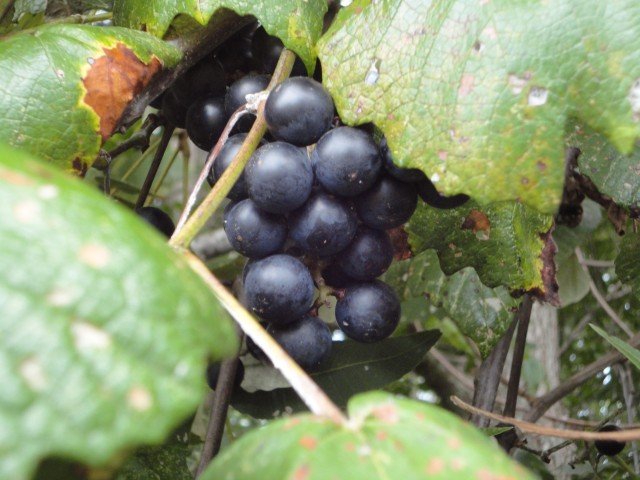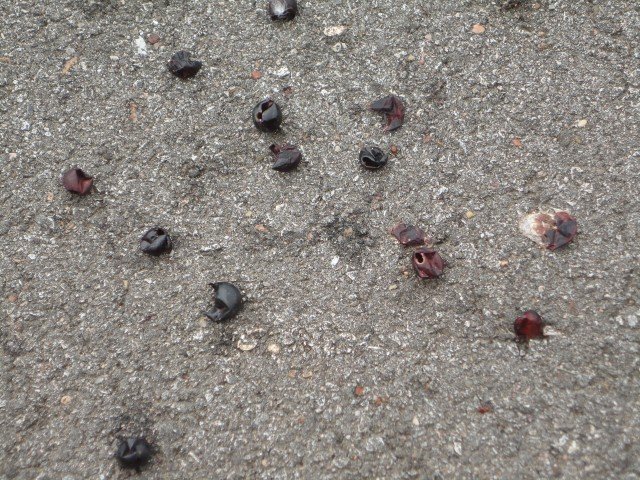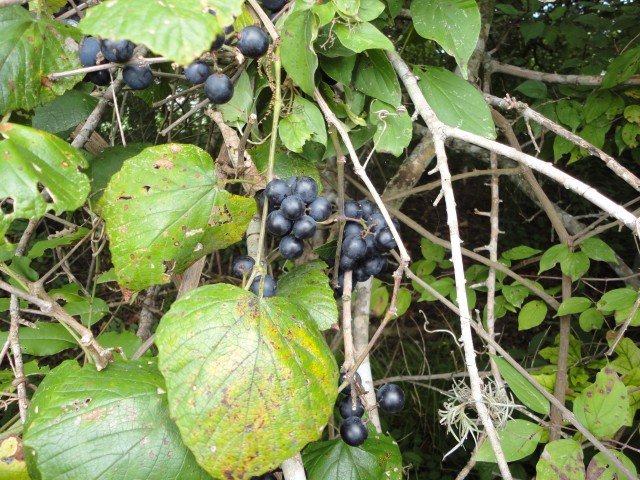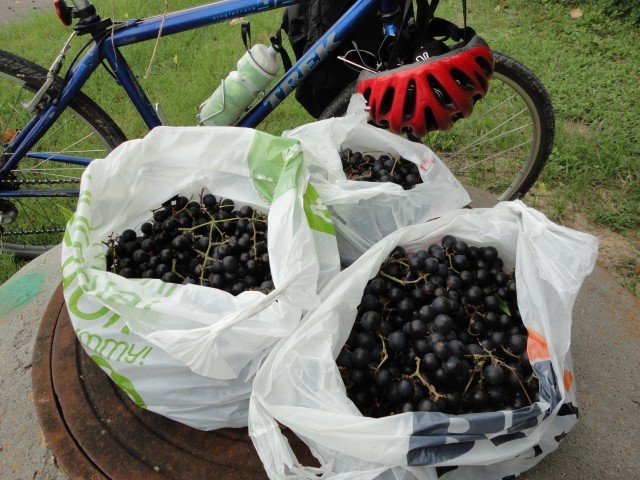Living in Houston, TX does not invoke images of the wild and untamed world but every now and then one does find a surprise. Most often it is seeing wild life (feral pigs, deer, snakes, rabbits and alligators) while biking through the reservoir. A few days ago while riding my mountain bike along a less frequented bike trail along Mason Creek I came upon another surprise, wild grapes (Mustang Grapes – Vitis mustangensis).
I have seen wild grapes vines in addition to wild roses growing over trees and shrubs during my bike rides, but I never looked that closely. The only reason I even realized that there was some type of fruit ripening was that there were “fruit skins” discarded on the pavement, an indicator that birds, specifically Mocking Birds were eating wild fruit.
I stopped where there was the largest concentration of discarded fruit skin on the path and looked closer at the tree line a couple of yards away. I saw nothing until I walked closer to the tree line, one eye on the vines and another on the ground for snakes. As I got closer, I saw hundreds of bunches of deep purple, almost black grapes hanging on the vines from the ground all the way to the tops of the trees.
Combined with this primordial fear of snakes is our human desire to live so I confirmed that the grapes were in fact attached to grape vines with leaves and tentatively ate one of the grapes. The flavor was tart, very acidic, with minimal sweetness, but the essence of grapes was present. I waited for a few minutes to see whether I was going to double over with cramps or break out in a cold sweat, sure signs that I had consumed something poisonous, but I was fine. I ate a few more grapes and only then did I noticed that there was a slight tingling on my lips and tongue due to the high acidity.
At the time all I knew was that there were wild / feral grapes growing in abundance in the tree line along Mason Creek. Growing up in the northeast I initially thought that these grapes could be Concord Grapes, but I knew that Houston, TX is too far south for this variety. I then considered that these grapes were domesticated grapes that had gone feral (wild) from a hedgerow or old vineyard from a farming / ranch homestead from a time long before Katy, TX was just another suburb of Houston, TX.
I rode back to the house, a quick four mile bike ride, pulled out my backpack, gathered some plastic grocery bags and packed my camera and I rode back to where I found the grapes. It took some effort for the grapes do not grow in large bunches, but I eventually picked between 15 – 20 pounds of grapes with one eye on the ground for snakes.
I did not even come close to picking all of the grapes that I could reach and there was so much more beyond my reach. While I was picking the grapes, I would notice the Mocking Birds to swoop in, pick a grape and quickly fly away. I am sure that they were not pleased with me finding their secret stash. My thought was Mr. Mocking Bird, you have eaten my garden grapes, so now I am going to eat your grapes.
Back home I researched the grapes that I had picked and based upon the location, tartness, acidity, color, growing style and the underside color of the leaf I was able to determine that I had picked Mustang Grapes (Vitis mustangensis), a variety of grapes that indigenous to East Texas. Between the acidity, toughness of the skin and the fruit full of seeds I knew that Mustang Grapes have no place on the table to be eaten fresh. I did know that I was going to enjoy making jams and jellies from the grapes. Who would have thought that among the densely populated suburbs of Katy, TX that wild grapes that are growing among the trees along the roads and bayous.
Note of caution: Due to the high acid content of Mustang Grapes it is recommended to wear gloves when picking and to limit the amount of grapes that are eaten fresh. I followed neither of these cautions, but nonetheless, it is suggested.






8 comments
Skip to comment form
My mother-in-law used to talk about the great pies her mother made from the dried grape skins of the Mustang grape. I assumed the grape must be a slip-skin like the Concord to have that much flesh left on and to make the “skinning” a practical step. But since my mother-in-law was one of 7 or 8 sisters, the labor pool was available and free.
Have you picked up any lore about this practice? I was born in the wrong end (west) of Texas to know these grapes and the only wild thing I remember growing there was shinnery and tumbleweeds. Not much tame growing there either (drought and dust-bowl days).
Author
Cross,
Thank you for your comment on the post. You are correct, Mustang Grapes are slip-skin grapes. I have not read anything about a dried grape skin pie, but the idea sounds intriguing. There many frugal recipes that exist that use all of the available ingredients, unfortunately many of these recipes even if recorded are no longer being utilized. I do know of one grape recipe that I do want to try next year. I remember visiting an Amish family that my mother’s family had been friends with since the 1950’s and they would combine the juice and pulp of grapes grown on their farm with tapioca to make grape pudding.
Bill
Just saw a recipe for a green grape pie – uses green Mustangs picked in April or May before the seeds form. Our grapes are ripening right now and we just made a couple of batches of jelly and some syrup. Delicious on my pancakes this morning. Happy Independence Day to you!
My mother made jelly from the wild grapes that grew on & around her property in rural Henderson county Tx.
I so miss that wonderful jelly. I just picked about 8 cups of ripe grapes at mom’s place. I’m positive they must be Mustang grapes. I hope my jelly is as good as my mom’s was over 35 years ago!
We used to have an abundance of mustang and muscadine grapes, and we made a lot of jam from them. It was my dad’s favorite, and I remember the year he had picked a huge black garbage bag FULL and dragged it to my kitchen for me to magically whip up a few million jars of the stuff. He passed away two weeks ago, and I’d love to make some to give my sisters in memory of him, but I’m not very mobile. Would an old lady scooter be able to maneuver on the path, and where on Mason Creek were these vines? I’m in Katy, so was thrilled to see your post when I started searching online where to find them!
I’m not sure where you can still get a hold of wild grapes. Maybe the foraging website fallingfruit.org could help you.
For those seeking out Mustang grapes, head over to Christia V Adair Park, West of Cullen Boulevard near Pearland. The fence on the Left as you go in. As always, follow the birds.
My sister used to make pretty good wine from Mustang grapes picked east of San Antonio.